John Simm (John Sim), 1829 - 1904
by Brian Stevenson
last updated February, 2022
A self-taught naturalist and slide-maker, John Simm produced good quality microscope slides from about 1860 through the end of the 19th century. Simm was a coal miner. During mining, contaminating rocks along coal seams were removed and discarded in piles near the pit head. The majority of Simm's mounts are of fossils that he collected from shale in those waste heaps. He was well-regarded in his time by professional geologists and other scientists. A fossil reptile was named Labyrinthodontesaurus simmii in his honor.
In publications, Simm spelled his name as both “Simm” or “Sim”. Those records, plus similarities in handwriting and specimens, indicate that slides labeled “Jno. Simm” and “J. Sim” were made by the same man.
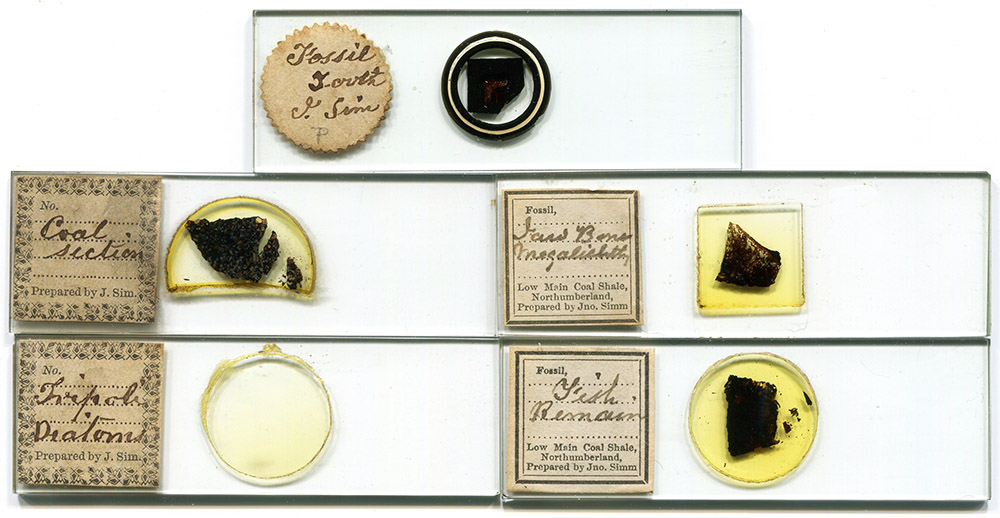
Figure 1.
Examples of microscope slides that were prepared by John Simm. His published writings indicate that he variously spelled his surname as “Simm” and “Sim”. The cover slips of the slides on the right were evidently broken before Simm applied them, probably because his poverty would not permit him to discard imperfect supplies. Additional examples of Simm’s work can be seen in B. Bracegirdle’s ‘Microscopical Mounts and Mounters’, plates 31-S and 33-M.
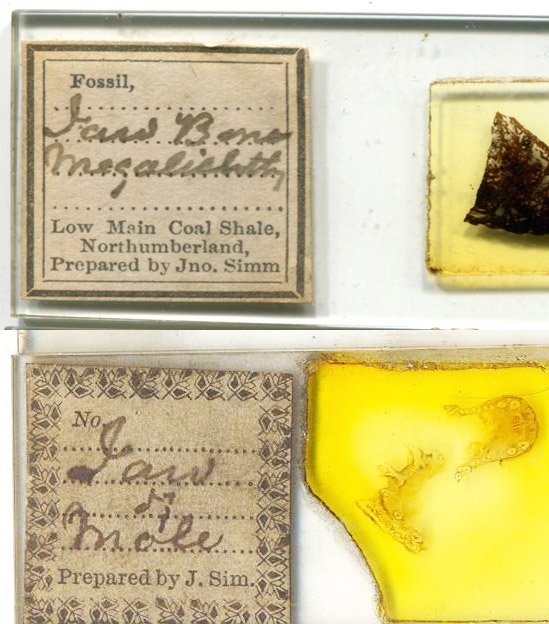
Figure 2.
Labels of slides signed “Jno. Simm” (top) and “J. Sim.” (bottom). Note that “Jaw” is written in the same hand on both labels. Images adapted from an on-line auction site for nonprofit, educational purposes.
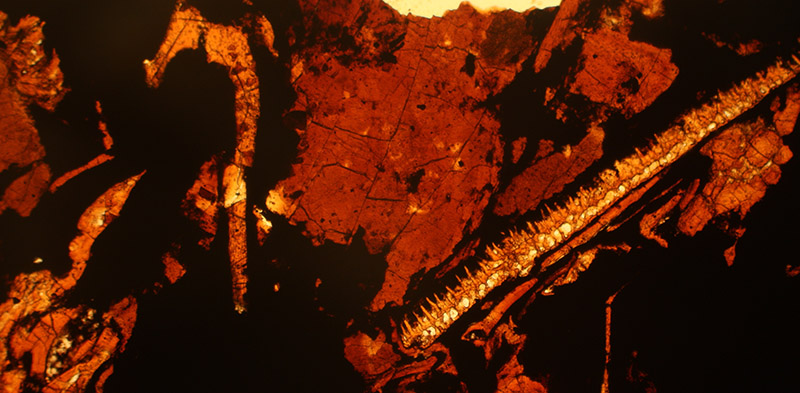
Figure 3.
Detail of “Fish Remains” (Figure 1), photographed using a C-mounted digital SLR camera on a Leitz Ortholux II with a 3.5x objective lens.
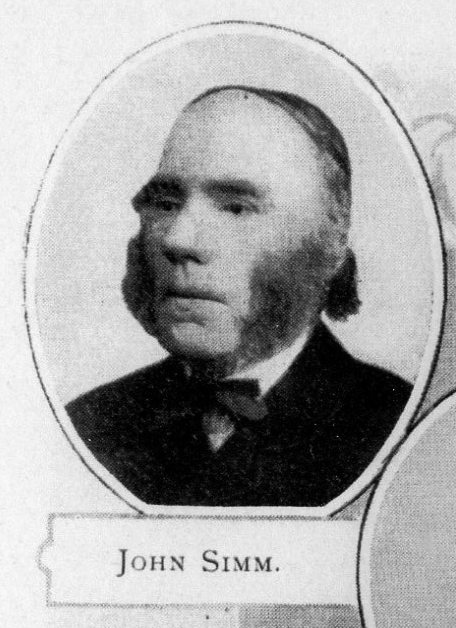
Figure 4.
Photograph of John Simm. From the cover of booklet on the Cramlington Co-Op, of which Simm was a founder. Generously provided by Joanna Lawson..
John Simm was born in late 1829, and was christened on November 15 of that year in Allendale, Northumberland, England. He was the fourth of eight children of Oswald and Isabella Simm. As did his father, brothers, and most of his relatives, John mined coal for almost his entire life. The 1841 census recorded that the 11 year-old John was a “coal miner”, as did all other censuses, including the 1901 census, when he as 72 years old.
The Simm family moved to West Cramlington, near Newcastle, during the 1840s. John married Margaret Robson there in 1852, and had at least five children. The couple remained in West Cramlington for the remainder of their lives.
Despite a hard life spent laboring underground for most of each day, Simm taught himself many aspects of nature, and took evening classes when possible. In an 1875 report, Edward Young wrote, “The following notices of some miners in the Northumberland and Durham coal-fields, which have been furnished to the author, will be read with interest: John Simms, West Cranleyton (sic), son of an ingenious miner who died several years ago; his son John works in West Cranleyton (sic) colliery, and has worked there from boyhood; he is about forty years of age; works as a heaver of coal. He has made great progress in the study of the fossil and reptile remains of the north coal-districts, and as a very large and good collection. He also works with the microscope and prepares microscopical objects; his preparations of fish-remains are very good. He is interested in butterflies and moths, and his knowledge of local natural history is very creditable”.
Among his scientifically-inclined colleagues was his brother-in-law, Joseph Taylor, also a notable preparer of coal fossil microscope slides. R.D. Roberts wrote "I can add the names of Mr. John Simm, West Cramlington, and Mr. Joseph Taylor, Shiremoor, both pitmen, who are able local geologists. They are also, although middle-aged men, students at the local lectures. I visited Mr. Simm last term, and spent a very pleasant afternoon at his house. He has a valuable collection of fish remains from the coal measures, collected by himself; and he has prepared with much labour a large and beautiful series of thin sections for the microscope. His knowledge of the local geology and palaeontology is extraordinary, considering the difficulties he has had to overcome. With better educational facilities the difficulties of such men would be greatly lightened".
Simm’s earliest known publications were written in 1866, when he was 36 years old. Both appeared in Hardwicke’s Science-Gossip. They indicate that, even though he worked hard as a manual laborer, he was alert to the scientific implications of his surroundings:
“The Shale Heap - What is a shale heap, and what possible interest does it present worthy the attention of the readers of Science-Gossip? To the first question I answer: A large heap of refuse will be found at all collieries; but the shale heap is only found at those collieries working the low main tier of coal, and is formed principally of the black, slaty stone - hence its name - which immediately overlies the above-mentioned bed of coal, varying in thickness at different collieries in this district. It will be found at Dudley and the Cramlingtons to run about two inches in thickness, although I have fell in with pieces at Newsham Colliery more than four times that thickness. To the second question: The shale heap is interesting to the naturalist and the collector of fossils for microscopic objects. Vegetable fossils will occasionally be met with, but it consists chiefly of fish remains, such as jaws, spines, teeth, scales, and loose bones. For a very obvious reason, jaws and spines are not so readily met with as teeth and loose bones. Some very fine specimens, however, of jaws have been found, varying considerably in the number of teeth attached to them; but when ground and mounted, and examined through the microscope, present a most beautiful and interesting object. In no instance have I found, in my few years experience as a fossil seeker, among this shale the slightest trace of the impression of a fish; while in the thin dark blue layer of stone, which crops out at the crag near Cullercoats, they appear to be common; the impression found there is planted on the stone in a most excellent manner. But no jaws, teeth, or scales, to the best of my knowledge, are found there. On two occasions, lately, parties of gentlemen from Newcastle and South Shields paid a visit to the shale heaps at Dudley and the Cramlingtons, with leather bags suspended from shoulder, hammer and chisel in hand, splitting and breaking, and splitting again until a bone, tooth, or jaw was found, which was immediately bagged, with as much interest as a disciple of Izaak Walton would creel a member of the finny tribe just drawn from its native element, to the no little amusement of the youngsters, and to the utter amazement of several of the seniors of the colliery village, as to what the gentlemen could want or find among the black stones on the pit heaps, although there are others courteous and willing to assist them whenever they come.-John Sim, miner, West Cramlington Colliery”.
“Observations on Fossils – While engaged with more of my fellow workmen, in pursuing my daily vocation in the mine, I came in contact with a fault (commonly called by miners a trouble). As the seam was broken, we had to return a considerable distance, and cut a passage through several strata, before we could again reach the bed of coal. I intend to give a few particulars of the fossils we met with in the different strata through which we passed, as they may be of interest to readers of S.G. I examined some of them with much care as we moved slowly and carefully along in our dark cavern. A layer of blue stone, about two feet thick, which had spread over the black shale, was the first that we had to cut through. As soon as we commenced operations, I instantly observed the bed of two spines of fish. They were both bent a little to one side, an occurrence which appears to be quite common, but the cause of which may not be so easily explained. Some beautiful specimens of fossil plants, such as Cones, Sigillaria, Calamites, and a variety of ferns, are generally found in this layer; but in this place I was much disappointed in finding nothing more than a small piece of the inner bark of Sigillaria. We passed through a mussel bed, the shells of which were neither so fine nor so neatly formed as some that I have seen from the same layer (or bed) in other parts of the district. I may also say that there is another bed of mussels met with about the same distance below our coal bed, as this is above it, both of which contain the same species, although they must have lived and died some thousands of years from each other. We came in contact with another layer, which contained a large quantity of coarse Calamites, stretching along the plane of stratification for several yards; and then we lost sight of them, possibly never to see them again. A layer of thin blue clayey stone next formed our roof for a short way on our journey, which was a complete mass of fern-leaves. These were more clearly impressed, and presented an appearance in the flora line more magnificent than any I had previously witnessed in the mine. What a great amount of pleasure and delight any lover of botanical science would have enjoyed in gazing upon the scene above, as thousands over thousands of the leaves of this fern fell upon the eye, as the rays of our candles shone so brightly upon them. The dark subterranean passage would have flown from his mind, and with it the vague idea of impressions, and he would at once have thought he was taking a ramble along the surface, searching and gathering some interesting species, where nothing but living ones were growing. Again, I might say, what a world of pleasure there was to me to think or reflect upon the time they grew and flourished, and when great unsightly beasts may have wandered among them in search of food, and made the woods echo with their wild and hideous roars! Probably no bird of sweet note cheered them in their wanderings, and no human being sat and watched their unwieldy movements! But, back to my story. The substance on which those leafy impressions were made, was so exceedingly brittle, that, notwithstanding all my caution, I could not procure more than one or two pieces to grace my cabinet. We passed through several other layers containing fossils, that seemed to have flourished in a rich vegetation, and may have borne the cold and chilly winds of autumn and the severe frosts of winter, and adorned and beautified the landscape in summer by their green foliage, and at last have fallen to the earth and left their impressions to be found and described by men of science some thousands of years afterwards. Layers of a hard and stubborn nature yielded to us, and opened out their long-hidden treasures, and Nature revealed without ink or pen her great and glorious work, and showed with what magnificence she has planted her impressions in the different leaves or layers of her book. A little before we reached the coal-bed, part of a spine of a fish was met with, which may have been pitched from its own bed (black shale) by the eruption that had torn asunder the solid layers of strata. Lyell, speaking of the coal-field in Wales, says, ‘It has been observed that in the overlying shales of the beds of coal in Wales, no Stigmaria plants have been found; yet in the underclays which form the floor, on which one hundred seams of coal rest, Stigmaria appears to abound. All the upper shales through which we passed presented no traces of Stigmaria. A few feet below our coal-bed, a blue clayey layer of stone is found, which contains nothing but the leaf-like rootlets of Stigmaria, branching out in all directions, and making it at times a very pleasing and interesting scene. - John Sim (Miner), West Cramlington”.
The following year, 1867, Simm published the following exchange offer in Hardwicke’s Science-Gossip, the earliest known advertisement of his microscope slides, “Fossil fish teeth and bones (mounted) for slides of Photographs. – John Sim, West Cramlington”.
During 1871, Thomas Barkas published two descriptions of fossils from early reptiles, both based upon samples provided by Simm. In Barkas’ description of a tooth of Amphisaurus amblyodus, he wrote, “I am indebted to Mr. John Sim, of West Cramlington, for the very excellent section of the tooth which furnished the illustration annexed; and to that gentleman and Mr. Joseph Taylor I am deeply indebted for valuable aid in making an almost complete series of sections of remains of coal-measure fishes and reptiles”. In the second article, Barkas wrote, “I propose to name this oldest of known reptiles Labyrinthodontesaurus Simmii, the specific name being given in honour of Mr. John Simm, a Northumberland working miner, to whom I am much indebted for many excellent microscopic sections of coal-measure fossils and much valuable aid in the investigation of carboniferous palaeontology”.
The following year, Barkas wrote on another fossil find, “I am indebted to my friend and collaborateur, Mr. John Simm, of West Cramlington, for the opportunity of examining a new specimen of a very rare fossil known as Orthognathus reticuloses”.
Some years later, in 1882, Barkas wrote to Hardwicke's Science-Gossip, "A few days ago I had the pleasure of spending a few hours in examining the valuable collection of coal measure fossils gathered by Mr. J. Sims, a working miner at West Cramlington, Northumberland, and among the many specimens in his collection gathered from the Low Main Coal Shale, I saw a group of fragments of shale which he had obtained from a then unworked seam of coal which lies a few feet from the Low Main, and was passed through in driving a drift through a fault, from Low Main to Low Main. The shale is hard and black, and the fragments of coal upon it are hard and shining. This shale is very rich in fossil remains, in fact it is crowded, and on the few specimens I examined I found the characteristically tipped teeth of Pygopterus, spines of Acanthodopsis ; scales and head bones of Cælacanthus, scales of Rhizodopsis, teeth and scales of Megalichthys, lanceolate tooth of Loxomma, teeth of Diplodus, teeth of Helodus ; these I found during a most cursory examination, and the only regret I felt was that more of the shale had not been obtained, as it is now finally buried from view. I also found a large tooth resembling Helodus and Psammodus in external markings, but not in form,"
Simm published the following exchange offers during 1880: “Will send four good slides of fossil fish remains, for two slides of tongue of drone fly, and two slides of the tongue of house fly, or blow fly. - John Simm, West Cramlington, Northumberland”, and “Dozen of young plants of Vallisneria, for half-a-dozen microscopical sections. - John Simm, West Cramlington, Northumberland”. Vallisneria is a freshwater plant, which Simm offered in exchange for the next several years. Thomas Davies, in his Preparation and Mounting of Microscopical Objects, recommended live Vallisneria as an interesting object for microscopic observations of fluid circulation in plants, and provided directions for its cultivation.
As noted above, Simm exhibited curiosity about many aspects of nature. In 1872, he published a short note in Hardwicke’s Science-Gossip on “Spring visitors”, “Swallow, April 23rd; Corncrake and Cuckoo, 24th; Blackcap, 26th. The weather very unfavourable at the time, and continued extra cold for several days after their arrival. Yet, notwithstanding all this, their appearance this year is a few days sooner than usual. - John Sim, West Cramlington, Northumberland”.
He wrote a colorful and wide-ranging essay on “Objects of interest in our pit district” in 1885: “A stranger travelling through our district would meet with no rugged scenery, or headlong waterfall. For a radius of a few miles, he would find he was entirely free from any mountain, and a level piece of country would stretch before him. Looking eastward, he would have a clear sea view of the sea only a few miles distant. Turning in any other direction, he would see numerous small plantations mixed with farm houses, and a few villages teeming with a busy population. If he were fond of botany, he would find some very interesting plants. If an ornithologist, he would see some fine rookeries, as well as flocks of starlings. The latter used to be a migratory bird, but has now, for several years, remained all the winter through. Often have I stood in the summer evenings watching their movements. Magpies he would not see, as they have for more than twenty years entirely deserted our district. The conduct of our youngsters, I fancy, will have been the cause of their desertion. The ornithologist would only on very rare occasions meet with any blackcaps, as they are with us fast dying out. Two species of wagtail stay with us long after the migratory birds have left us. A lover of entomology would meet with the two garden white, red, admiral, small tortoiseshell, orange tip, meadow brown, painted lady, the small copper, and occasionally the peacock.
The small streams are well stocked with small fishes. I give an extract I once sent to a Newcastle paper on our stickleback. One fine summer evening, the sky very clear, the air quiet, the scenery calm and peaceful; and all nature appearing at rest, I took a stroll by the side of a gentle stream. In my company was a gentleman who was very anxious to be shown some nests of stickleback, as he had never before seen anything of the kind. As we wandered along, shoals of stickleback darted rapidly past us, for, with their keen sense of sight, they soon recognised us on the banks as strangers. We sat down on the bank, and the fish soon returned, and began their usual pranks. The males took their places and stood guard over their charmed circles, like the Roman soldiers of old went on doing their duty, and ready to die rather than be driven from their posts. My friend expressed much surprise to find all those having the prettiest colour to be the worst tempered. ‘Yes’, I said, ‘that is true, but let us look at their motive. You see those little raised mounds, with a round hole in the centre; they are nests, and the coloured stickleback you see close by are the males guarding their precious homes. The males have the places to select, the nests to build and to keep in order, the females coming when all is right, to deposit their spawn, and, unless the nests were closely guarded by the males, not only against the attack of other fishes, but even against the parents themselves, as the ova or spawn is always a precious meal to fishes, they would soon be destroyed’. Their colour I have found to be mostly due to their valour in fighting, the bolder they are the more fierce they look, and the more courage they show in defending their nests the more colour they get. I have frequently seen females go from nest to nest, depositing ova without being molested. Yet, at the same time, I have seen them chased away, when I much fancied they had not any ova to deposit. The nests I could see were repeatedly visited by the males. 1st. To see the nests are kept in order, and to make fast any loose material by a gummy substance which they have the power of discharging. 2nd. The eggs of the female have to be fertilised by the males; without this the fecundity of the eggs would not take place. Now these eggs, and those of snails, frogs, &c., that I have examined, are the same shape as the eggs of birds, when viewed under the microscope. As I was in want of a nest for my home aquarium, my friend insisted on taking one home. He stretched himself across the stream with his head close to the nest which he wanted, and which was only a few inches under the water. As be listened very attentively, he fancied he heard something moving. Presently the whole brood of young ones came away, and so fascinated were we with the sight before us, that a few seconds passed away before we could speak to each other again. He took off his round felt hat, and indented the crown so as to hold about a pint of water. Into this miniature vessel he placed the whole shoal of young. This mass of life, so newly ushered into existence, was to us the most interesting of all sights we had before witnessed. I have found these last few years, that that pretty little fish the minnow fails to keep its own in the struggle for existence, in some of our very small streams. Where it used to be plentiful, it has now entirely died out. They fail to stand the repeated attacks of the pugnacious sticklebacks.
The traveller in our country would pass acres of land, scarcely fit to graze a single animal. On his route he would notice a peculiar looking hill, or heap, varying in different shades of colour, mingled with patches of the coarsest of grass, to which no living animal would care to give a passing glance. All the strata are cut through, when sinking a pit the rubbish is sent away. When the pit gets under way, falls of shale are almost of daily occurrence, and the greater part of this shale has to be brought away, which soon makes the heaps grow larger. The geologist will perhaps find in no part of the world so rich in fossil remains, as those refuse shale heaps, met with at our colliery places. If he were to split some of the shale open, he might find abundance of fossil mussels, such as Anthracosia, as well as of fossil ferns and other plant remains, and thus discover that even in our district there is plenty of interest, although it is only a Pit one! John Sim, Northumberland”.
The last record of Simm’s life yet located is an 1894 exchange request, “Limestone sections for the microscope offered for ‘Starland’ by Prof. Ball, or the recent book on Sir Samuel Baker’s travels. - John Simm, West Cramlington, Northumberland”. Simm accumulated a considerable library, as evidenced by a donation from his daughter, Jane, to the Natural History Society of Northumberland, Durham, and Newcastle-upon-Tyne of “About 150 books, chiefly on Natural History, from the Library of her father, the late John Simm of West Cramlington”.
Simm was actively working in the coal mines when the 1901 census was taken. He died three years later, at the age of 75.
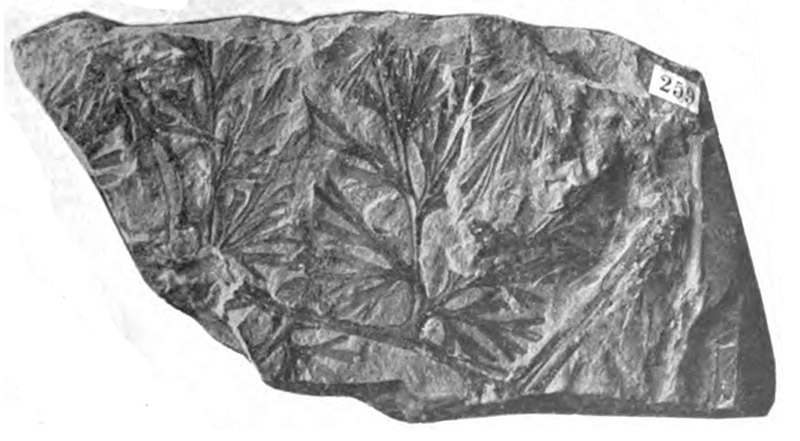
Figure 5.
Fossilized plants from the collection of John Simm. Adapted from an article by Robert Kidston in the ‘Proceedings of the Yorkshire Geological Society’, 1902, captioned “Spheiurpteris furcata Brongt. Cramlington, Northumberland. Lower Coal Measures [259]. Natural size. Collected by Mr. J. Sim”.

Figure 6.
Detail of “Jaw Bone of Megalichthys”, (Figure 1), photographed using a C-mounted digital SLR camera on a Leitz Ortholux II with a 3.5x objective lens and crossed polarizing filters.

Figure 7.
Detail of “Jaw Bone of Megalichthys”, (Figure 1), photographed using a C-mounted digital SLR camera on a Leitz Ortholux II with a 3.5x objective lens.
Resources
Many thanks to Joanna Lawson for providing images from a Cramlington Co-Op booklet.
Resources
Barkas, Thomas P. (1871) Tooth of Amphisaurus amblyodus, English Mechanic and World of Science, Vol. 12, pages 540-541
Barkas, Thomas P. (1871) The oldest true reptiles, English Mechanic and World of Science, Vol. 13, pages 207-208
Barkas, Thomas P. (1872) Orthognathus reticulosus, English Mechanic and World of Science, Vol. 14, page 430
Barkas, Thomas P. (1873) Illustrated Guide to the Fish, Amphibian, Reptilian, and Supposed Mammalian Remains of the Northumberland Carboniferous Strata, W.M. Hutchings, London
Bracegirdle, Brian (1998) Microscopical Mounts and Mounters, Quekett Microscopical Club, London, pages 85, 166, 170, and plates 31-S and 33-M
Cook, E.T. (1884) The university extension movement, quoting R.D. Roberts, in Proceedings of the International Conference on Education, Vol. 4, edited by R. Cowper, published by W. Clowes and Sons, London, pages 252-266
Davies, Thomas (1863) Preparation and Mounting of Microscopical Objects, Hardwicke, London, pages 143-144
England census, birth, marriage, and death records, accessed through ancestry.co.uk
Hardwicke’s Science-Gossip (1867) Exchange offer from John Simm, Vol. 3, page 240
Hardwicke’s Science-Gossip (1880) Exchange offers from John Simm, Vol. 16, pages 192 and 216
Hardwicke’s Science-Gossip (1882) Note from the Editors, “John Simm - Accept our best thanks for the coal fossils”, Vol. 18, page 263
Hardwicke’s Science-Gossip (1883) Exchange offer from John Simm, Vol. 19, page 216
Hardwicke’s Science-Gossip (1884) Exchange offer from John Simm, Vol. 20, page 192
Hardwicke’s Science-Gossip (1894) Exchange offer from John Simm, page 96
Kidston, Robert (1902) The flora of the Carboniferous period, Proceedings of the Yorkshire Geological Society, Vol. 14, pages 189-230, Plate XXVII
Simm, John (1866) The shale heap, Hardwicke’s Science-Gossip, Vol. 2, page 18
Simm, John (1866) Observations on fossils, Hardwicke’s Science-Gossip, Vol. 2, page 111
Simm, John (1872) Spring visitors, Hardwicke’s Science-Gossip, Vol. 7, page 138
Simm, John (1885) Objects of interest in our pit district, Hardwicke’s Science-Gossip, Vol. 21, pages 31-32
Transactions of the Natural History Society of Northumberland, Durham, and Newcastle-upon-Tyne (1921) “Mrs. J.A. Wilson (Cramlington) - About 150 books, chiefly on Natural History, from the Library of her father, the late John Simm of West Cramlington”, Vol. 5, page xxx
Woodward, Arthur S, and Charles D. Sherborn (1890) “Mr. John Simm and Mr. T. Cragges, of West Cramlington, and Mr. Joseph Taylor, of Shire Moor, have also done much in their respective districts”, A Catalogue of British Fossil Vertebrata, Dunlau & Co., London, page xi
Young, Edward (1876) Labor in Europe and America, S.A. George & Co., Philadelphia, page 417






